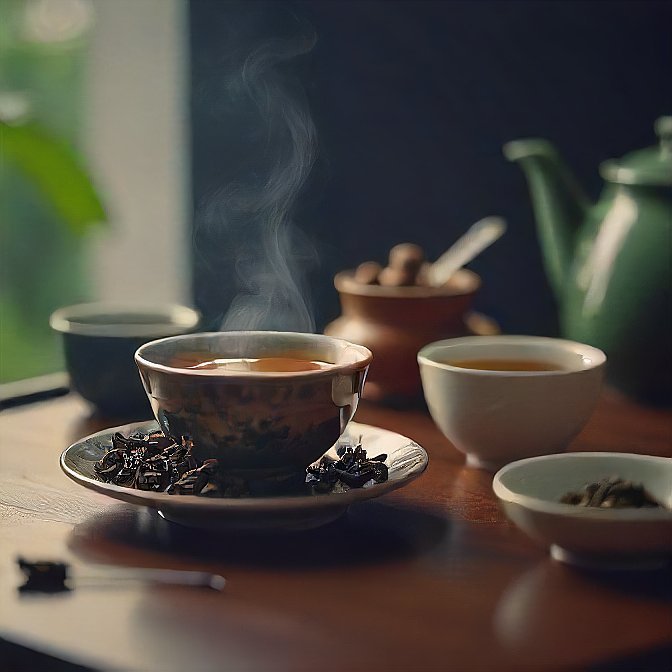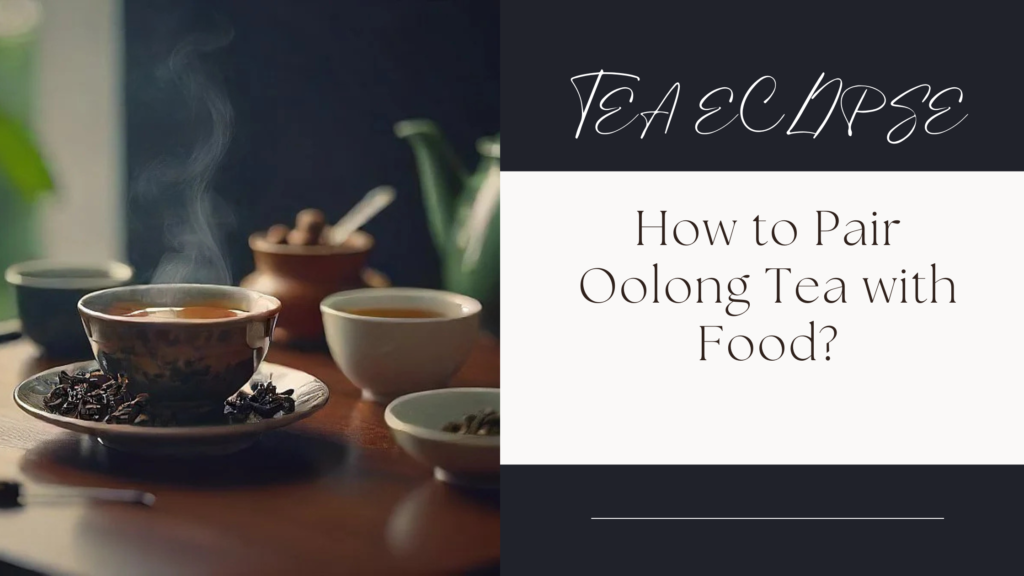Table of Contents
When it comes to tea types, oolong tea has always been dear due to its methods of preparation, taste, and sustainability in usage. More recently, the idea of matching tea to food in a similar fashion to wine has been endorsed, and oolong tea, being a tea that has a range of taste profiles, promises to deliver a wide variety. From complementing a particular meal or a dessert, oolong tea can help to boost flavors, refresh or even define eating as people know it.
From the above classifications, we can proceed to discover some of the flavor characteristics present in oolong tea, learn if it is suitable for accompanying various savory foods and sweet delicacies, and top it up with some useful guidelines on how one can prepare complimentary oolong tea meal combinations.
Introduction to Oolong Tea

Oolong tea is arguably unique right now as regards the type of tea, it is semi-oxidized and forms a bridge between both green tea and black tea. This type of tea undergoes a partial oxidation process in processing and this makes oolong tea have a unique taste and texture. The oxidation level will mean that the tea is now leaning towards the greener taste or if the tea now has a darker taste. This makes oolong versatile to be a partner for foods since it can change slightly and reciprocate with the food.
It, for example, stems from China and Taiwan, where skilled tea masters who for centuries have been working on this tea have perfected ways of creating oolong tea with special tastes. Oolong tea is prepared partially oxidized; therefore, it is in between fully oxidized black tea or no oxidation green tea, and it offers a blend of both the qualities: grassy fresh flavor and malt-like deeper flavors.
The History and Benefits of Oolong Tea
Many people are convinced that the name ‘oolong” originates from the name of a tea farmer named Wu Long. Having experienced and experimented, he discovered that the tea, which was prepared from leaves that were partially oxidized before drying, had a good taste. After that, oolong became one of the most important teas in the Chinese and Taiwan tea industries, various areas have their style of oolong tea.
Apart from this heritage, oolong tea has the following health benefits: Oolong tea, along with other classes of tea, contains flavonoids, of which the most significant are catechins and theaflavins, which help to prevent oxidation within the body. Another study suggested that oolong tea could also assist in decreasing the fat as well as cholesterol in the body which would have a positive impact on the heart while containing a moderate amount of caffeine that should help the mind to be alert. Also, oolong tea has been associated with several health benefits, in particular with digestive health, thus complementing food combinations.
Understanding Flavor Profiles in Oolong Tea
- Semi-Oxidized – These teas are relatively close in oxidation to light Oolong teas and Light Oolong Teas have floral, fruity, cream-like tones. Loose-leave oolong teas, such as Tie Guan Yin, or Alishan, are said to have a light and fresh flavor, the aftertaste is similar to gardenia honeysuckle, or juicy peach. These teas are best suited for eating with foods that do not have heavy ingredients, such as salads, fish, and cheeses.
- Granulated Oolong – The even more oxidized oolong teas have thicker, stronger, and taste resembling that of black teas’. Dark oolongs, which include Da Hong Pao or Wuyi Rock tea, have roasted, nutty, or caramel-like properties with hints of earth.
Pairing Oolong Tea with Savory Dishes
- Dark Oolong with Roasted Meats – The order of preference is again a darker and fully oxidized oolong tea, as the roasted flavor goes well with any roasted meat, such as pork, beef, or lamb. For those who are wondering which tea goes best with Wuyi Rock, I’ll tell you that it complements the taste of grilled or barbecued meats.
- Vegetarian Foods – Oolong tea is also wonderful with vegetarian food because of mushrooms, tofu, or even if soy sauce is used in cooking. The earthy, roasted taste of a dark oolong tea will complement the umami taste well and a light oolong tea will complement the freshness of the vegetables well.
- Asian Cuisine – As we have seen above, oolong tea has its roots in China and Taiwan, and therefore, it is most suitable for Asian foods. Oolong tea is especially helpful in washing away greasy flavors and adding a clean, refreshing note to many dishes, particularly those of the dim sum, stir-fried, and noodle varieties. Tannins from the tea help to reduce the oiliness of fried foods, and as such, they can best be paired with dishes such as dumplings, spring rolls, and the like.
Check Out: Can Ceylon Black Tea Help with Weight Loss?
Pairing Oolong Tea with Sweet Treats
- Ideas for service – served with delicate fruit tarts or sorbets, light and fruity oolong goes well with fruits or fruit salads. The tea has a nice subtle sweetness to it which makes it compliment the natural flavor of the fruits.
- Creamy Desserts – Heavier meals like cheesecake and crème brûlée will most likely require the darker version of the tea since it does not complement the creamy texture of the dessert. The bitter undertones of dark oolong teas bring out the sweetness of the dessert as well as extend the flavor profile of food, drinks, and desserts.
- Chocolate Desserts – Different dark oolong teas are great to be paired with roasted and nutty flavors like in chocolate desserts. Such a slight bitterness of the tea can complement the sweetness of the chocolate combined with a multilevel taste, which will make the dessert. An ideal combination with a dark oolong tea will be a flourless chocolate cake or dark chocolate truffles.
Tips for Creating Your Perfect Pairings

- Think about the Intensity – similar to other combinations like Wine and food, it is essential to also think of the intensity of the tea and the dish in question. Fragile oolong, which has a subtle flavor, is good to be served with light food, while heavily-flavored oolong is perfect to be served with dense food.
- Balance the Flavors – Try to see that the tea that is served compliments the food in terms of flavor. They should not overwhelm the taste of the dish but rather complement the dish in its taste. For instance, a floral oolong tea will cut the creaminess of a dessert in equal measure, while a roasted oolong, is the smokiness of barbeque meats.
- Try out Temperature – This can be done in the oolong tea and its compatibility with foods as well as taste changes according to the serving temperature. For instance, oolong tea properly self.ToDecimaleres hot and iced versions are different; as a result, do not restrict yourself to the hot and iced tea combinations only.
- And finally, tuning your preferences – finally, the best pairings are the ones that you like most. Go by your taste buds and avoid being rigid on what you should and should not mix. If there is one thing that producers can appreciate about oolong tea, it would be the fact that it is so adaptable to a piece of music that no matter what type of food or perhaps even beverage it would be paired with, the producers have so much leeway in both taste and texture.
Conclusion: Enjoying the Versatility of Oolong Tea
For instance, it is possible to match a floral and soft oolong with seafood or a high rum raisin style oolong with a chocolate cake which rather adds a twist to food and beverages pairing. This way, one will be equipped with knowledge about various oolong tea varieties and how they will connect with each type of dish that is available, thus enhancing its taste to create memorable meals.
For more info: Click Here.
FAQs
What is oolong tea?
Oolong tea is a Chinese tea, which is processed halfway between green and black tea so it has slight hints of taste of both these kinds of tea.
What are the health benefits of oolong tea?
Oolong tea is a source of vitamins, minerals, and antioxidants and it’s effective in managing weight, boosting the digestive system as well as reducing cholesterol levels hence enhancing heart health.

